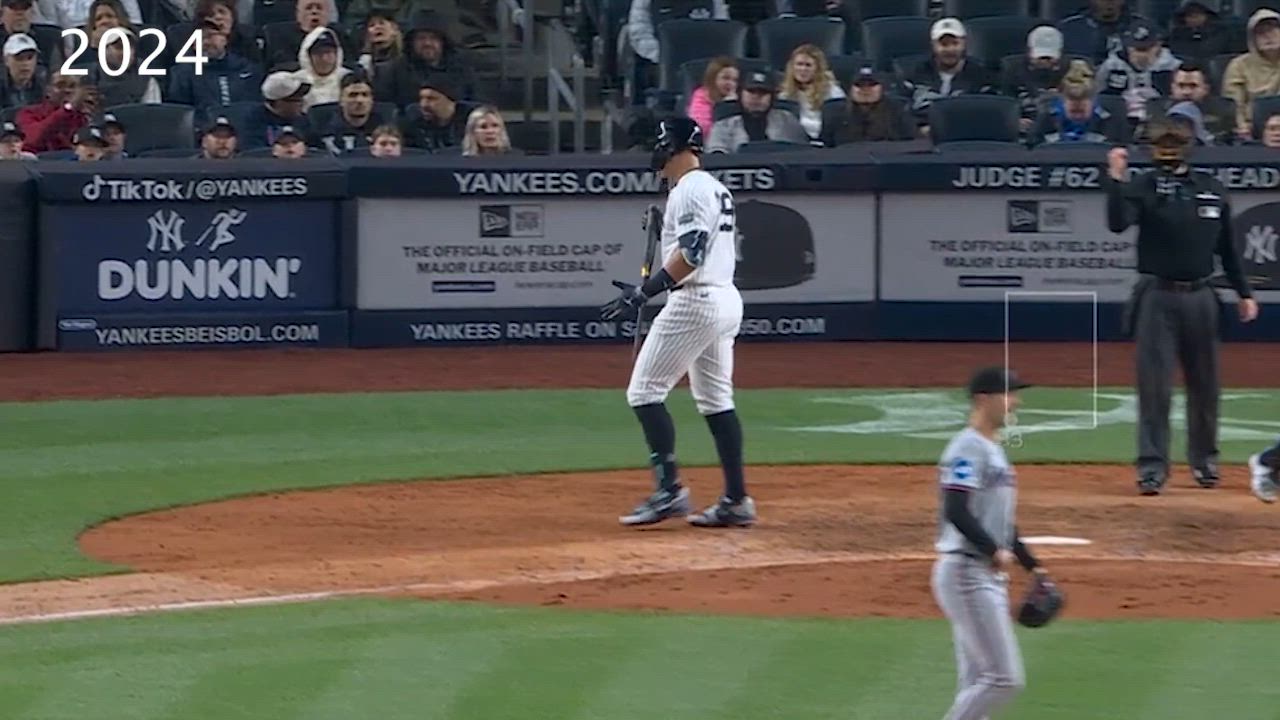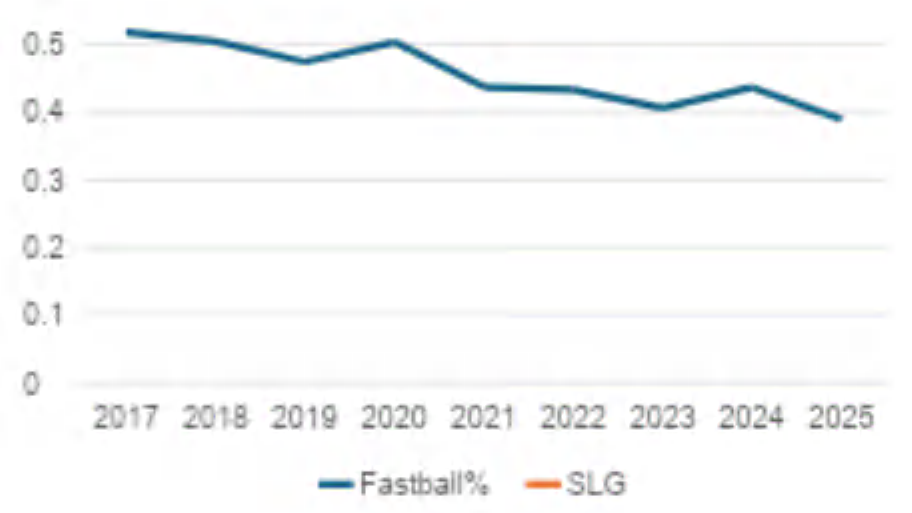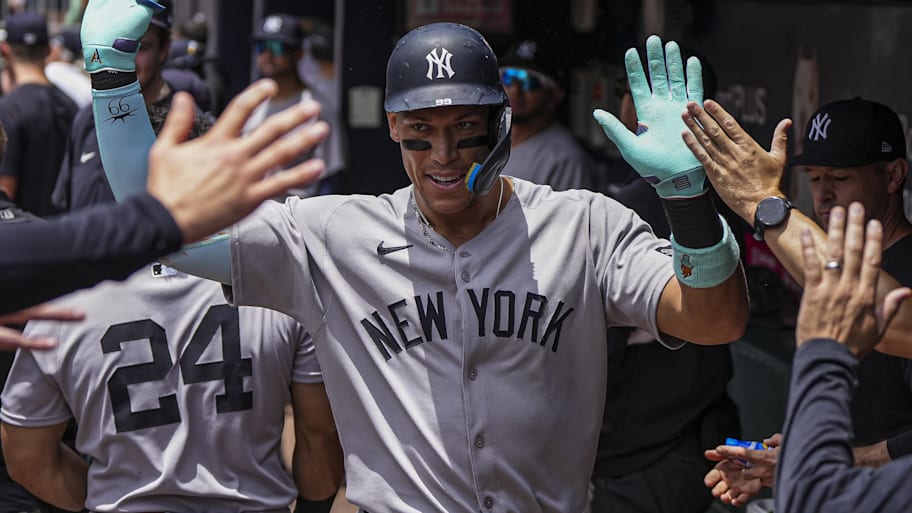One of the most thrilling and rare at-bats of the season took place at Fenway Park on June 13. Garrett Crochet was two outs from becoming the first Red Sox pitcher in 69 years to beat the Yankees 1–0 at Fenway Park in a complete game. Standing in his way, like a 285-pound roadblock, was Aaron Judge.
The thrill came from the star power and game situation. The rarity derived from Crochet’s plan of attack. As he had done all night, during which he struck out Judge three times, Crochet kept pouring in four-seam fastballs. Running the count to full, he deviated only once, throwing a 1–0 cutter to get a swinging strike.
With a 3-and-2 count, the world seemed to know what was coming, especially Judge. He pounced on a 99.6-mph fastball and hammered it 443 feet.

Over the past two seasons, there have been 13,723 pitches thrown at least 99 mph. None of them were hit as far as Judge smashed Crochet’s fastball. It was the pitch that best defined what Judge has become: better than ever at age 33, the best pure hitter since Albert Pujols and the best fastball hitter anybody has seen in the 18 years of pitch-tracking data.
Consider Blue Jays manager John Schneider convinced. On Monday night, Judge and the Yankees return to Toronto, where three weeks ago Schneider walked Judge intentionally five times in four games, a Yankees record for a series, including twice with the bases empty. Judge did his damage (six hits in 10 at-bats), but Toronto swept that series while taking Judge out of play in the most meaningful spots.
Judge is likely to make a mockery of those oversold MVP debates, especially with Cal Raleigh hitting .135 in July. Judge is on pace to hit .350 with more than 50 homers, which has been done only by Babe Ruth, Jimmie Foxx, Hack Wilson and Mickey Mantle, the last in 1956. He is on track to become the first player to hit 50 home runs and lead the league in hits. The most homers by a hit leader are the 47 by Ted Kluszewski in 1955.
Judge is a more aggressive and better hitter than he’s ever been, which is a mouthful considering he is in an historic four-year stretch of batting .313 and slugging .684 with 193 home runs—with 63 games still to go this year.
Most remarkable of all about Judge is how he destroys fastballs. You cannot throw Judge a fastball in the zone in any meaningful situation. He is too good. Look at this ranking over an 18-season sampling:
Highest SLG vs. Fastballs, 2008-25
(Min. 1,600 pitches; not including cutters)
This season Judge is hitting .466 on fastballs in the zone, the highest such average in the 18-season recorded history. Nobody is close to him this year; Vlad Guerrero is next at .383.
Opponents have taken note. Judge is seeing a career-low fastball percentage of 38.5%. Only Oneil Cruz, Gavin Sheets and José Ramírez see fewer fastballs. For instance, the Tampa Bay Rays, always on the cutting edge of pitch trends, have “held” Judge to a .586 slug this year by throwing him only 24% fastballs.
Judge may be seeing fewer fastballs than ever, but he also is doing more damage against them than ever. Here are his two amazing trend lines: As his fastball percentage goes down, his slugging against them goes up.

To find Judge more pitches to hit, Yankees manager Aaron Boone has hit Judge almost equally between second (48) and third (50) in the batting order, a change from last season when Juan Soto and Judge hit 2–3 virtually every game. Boone almost always puts left-handed hitters in front of and behind Judge. That’s why the return to power by Cody Bellinger has been a key to Judge’s season. Yankee Stadium’s short porch convinced Bellinger to move his feet closer to home plate again and to get the ball in the air to the pull side. His pull-side air percentage is the highest it has been since his MVP season of 2019.
When I ask Boone how he decides where to bat Judge, he says, “For the most part versus lefties we’ve had Goldie [Paul Goldschmidt] leading off all year. And then, generally speaking, I've hit him third with just either Bellinger or [Trent] Grisham [second]. Belly obviously has been great against lefties all year.
“But even Grisham, I feel like gives you the really good at bat. So, I've kept him there. And then as [Giancarlo Stanton] comes back, I put him in the four hole against lefties, just depending on how left, right, left, we are. I’ve kind typically gone left, Judge, Belly versus most righties.”
“I'm guessing to Judge, it really doesn't matter,” I say to Boone. “He doesn't care too much?”
“No. He loves hitting third,” Boone says. “He just kind of says it every now and then. If he hits second and it comes around and the lefty stays in the game, I'll point it out to him like. ‘You know, you're not facing that guy.’ So, he really doesn’t care.”
We are looking at one of the all-time great peaks to a great career. And Judge may only be in the middle of this peak. The way to get him out has always been to dot the down-and-away quadrant of the strike zone with spin and off-speed. Until this year, Judge hit .184 and slugged .307 against those pitches in that corner. This year he has closed that hole. In part by closing his stance, a move he made midseason last year, Judge is hitting .324 and slugging .559 on those same pitches.
Boone says part of Judge’s success has come from developing routines and adopting modalities to stay healthy and in the lineup. If not for a freak injury at Dodger Stadium in 2023, Judge might be looking at four straight MVPs. It’s not a cliché to say he improves every year into his 30s.
Judge by Age
Judge has built a booster rocket phase to his career. With two months left this year, he already has hit more home runs from age 30 to 33 (193) than any hitter except Sammy Sosa (226). Judge has grown from a great slugger in his 20s to an all-time great hitter in his 30s.
More MLB on Sports Illustrated
This article was originally published on www.si.com as Aaron Judge’s Success Against Fastballs Has Lifted Him Into Another Echelon.
